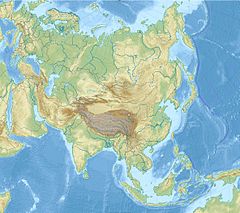
Back Oud-Turkse skrif Afrikaans የኦርኾን ጽሕፈት Amharic أبجدية تركية قديمة Arabic Orxon əlifbası Azerbaijani اورخون الیفباسی AZB Орхон яҙмалары Bashkir Alpabet Turkik na Robi BBC Орхонска писменост Bulgarian ئەلفوبێی تورکیی کۆن CKB Orchon-Runen German
This article needs additional citations for verification. (June 2019) |
| Old Turkic script Orkhon script | |
|---|---|
 A line dedicated to Bumin Qaghan in the Ongin inscription | |
| Script type | Alphabet
|
Time period | 8th to 10th centuries[1] |
| Direction | Right-to-left script |
| Languages | Old Turkic |
| Related scripts | |
Child systems | Old Hungarian |
| ISO 15924 | |
| ISO 15924 | Orkh (175), Old Turkic, Orkhon Runic |
| Unicode | |
Unicode alias | Old Turkic |
| U+10C00–U+10C4F | |
The Old Turkic script (also known as variously Göktürk script, Orkhon script, Orkhon-Yenisey script, Turkic runes) was the alphabet used by the Göktürks and other early Turkic khanates from the 8th to 10th centuries to record the Old Turkic language.[1]
The script is named after the Orkhon Valley in Mongolia where early 8th-century inscriptions were discovered in an 1889 expedition by Nikolai Yadrintsev.[2] These Orkhon inscriptions were published by Vasily Radlov and deciphered by the Danish philologist Vilhelm Thomsen in 1893.[3]
This writing system was later used within the Uyghur Khaganate. Additionally, a Yenisei variant is known from 9th-century Yenisei Kyrgyz inscriptions, and it has likely cousins in the Talas Valley of Turkestan and the Old Hungarian alphabet of the 10th century. Words were usually written from right to left.
- ^ a b Scharlipp, Wolfgang (2000). An Introduction to the Old Turkish Runic Inscriptions. Verlag auf dem Ruffel, Engelschoff. ISBN 978-3-933847-00-3.
- ^ Sinor, Denis (2002). "Old Turkic". History of Civilizations of Central Asia. Vol. 4. Paris: UNESCO. pp. 331–333.
- ^ Vilhelm Thomsen, [Turkic] Orkhon Inscriptions Deciphered (Helsinki : Society of Finnish Literature Press, 1893). Translated in French and later English (Ann Arbor MI: University Microfilms Intl., 1971). OCLC 7413840
